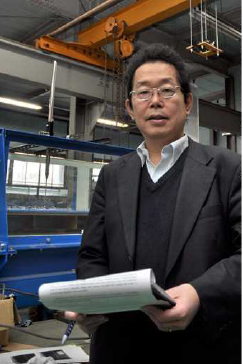 Clarify the complex environmental systems of the hydrosphere and develop measures to prevent and reduce disasters in it.
Clarify the complex environmental systems of the hydrosphere and develop measures to prevent and reduce disasters in it.Professor, Graduate School of Science and Engineering and the International Institute for Resilient Society, Saitama University
Doctor of Engineering: Aquatic environment engineering, applied ecological engineering, aquatic disaster prevention/disaster risk reduction engineering
|
1991 |
Graduation from the Doctoral Course, Graduate School of Engineering, the University of Tokyo |
|---|---|
|
2000- |
Saitama University, after working in a private company |
|
2007-2013 |
Professor, Graduate School of Science and Engineering and the Institute for Environmental Science and Technology (IEST), Saitama University |
|
2014- |
Professor, Graduate School of Science and Engineering and the International Institute for Resilient Society, Saitama University |
The hydrosphere, including rivers and coastlines, consists of environmental systems in which hydraulic (such as water flows and waves) and biological (including the acts of individual organisms and transitions of biological communities) phenomena occur on various time and space scales while influencing each other in a complicated manner. It has become increasingly important to understand the effects and influences of the systems on hydraulic (such as floods and tsunami) and man-caused (including changes in the hydrological environment and contamination) disturbances to develop a sustainable society.
My laboratory conducts research on the following subjects: methods for reducing disturbance effects on mangroves and lagoons, the behaviors of aquatic insects living in the downstream of dams, development of measures to respond to trees and plants growing in the courses of rivers (attributed to a decrease in the frequency and extent of disturbances due to floods), which interferes with water flows and causes drifts, protection of riverfront vegetation (such as reed) from the waves generated by running boats, and purification of water (to improve its quality) using emergent plants. Following the giant tsunami in the Indian Ocean, we conducted a study to determine its damage by defining sand dunes and, lagoons, and woodland as bio-shields, and developed a method for assessing their disaster-prevention effect quantitatively. We also proposed methods for designing/operating sustainable bio-shields to developing countries in South and Southeast Asia. Following the tsunami that caused severe damage in the Great East Japan Earthquake, increasingly higher expectations are raised in Japan for dunes and coastal forests to reduce damage caused by tsunami that would overflow banks.
An image of the research field as a whole
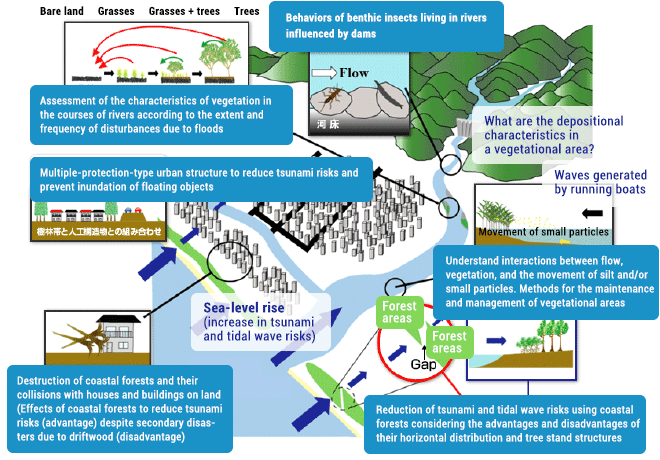
In relation to technological development for life in harmony with the environment, we conduct research on the following subjects: a combination of coastal forests, sand dunes, and banks to reduce tsunami risks in coastal areas, analyses of secondary disasters due to driftwood and the development of response measures, proposition of an urban structure designed to reduce disaster risks, prevention of the erosion of riverfront and bank vegetation attributed to the waves generated by running boats in the downstream areas of rivers, clarification of the relationship between the characteristics of floods and vegetational dynamics in midstream areas and the proposition of methods for the maintenance and management of rivers and their vegetation based on the results, and clarification of the relationships between the operation of dams and riverbed materials/aquatic insects in upstream areas.
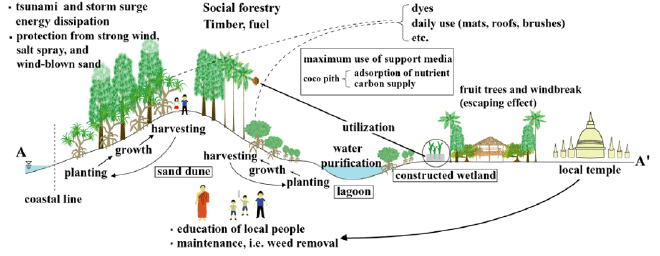

Our suggestions include the forestation of native species, planting mixed species to increase their mechanical strength, and the necessity of increasing residents’ motivation to maintain and manage the forests for a long period, such as social forestation.
(by Saitama University, the University of Peradeniya, and Matara City)

JSPS Asia and Africa Science Platform Program (AACORE): Sri Lanka researchers and Japanese graduate students who presented their research findings

A sign indicating a pilot project for the forestation of coastal forests to prevent and reduce tsunami damage
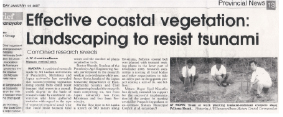
A newspaper reporting the activity of forestation of coastal forests by Saitama University in collaboration with the University of Peradeniya and Matara City to mitigate tsunami damage
(tsunami diffraction around sand spits and tsunami overflow from the river embankment)
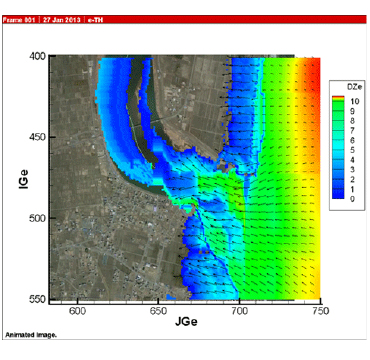
When the earthquake occurred in the Pacific Ocean of the Tohoku region, tsunami propagates propagated upstream along rivers in many regions, and damage was particularly severe in those areas hit by tsunami from the ocean and river sides.
The figure shows a result obtained from a simulation of tsunami propagating upstream along the Abukuma River and overflowing the bank. In this region, the severity of damage significantly varied from area to area, presumably depending on the structure of the river mouth and its geographical shape, including sand spits, bridges, and winding waterway. It is important to clarify the causes and identify rivers with a similar structure as important roles played by engineering.


© Copyright Saitama University, All Rights Reserved.